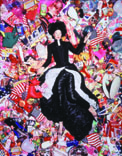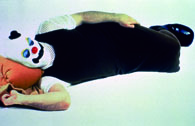Berlin-New
York
art is entertainment is art is entertainment is art...........
by Boris Moshkovits




David
Lachapelle, Couture Consumption, 1999, C Print,
20 x 24 inches
Noritoshi Hirakawa, The Reason of Life, 1998 C Print, 14 3/4 x 22
1/2 inches
Daniel Pflumm, Untitled (Kraft), 1998, lightbox, edition of 3, 22
x 55 x 6 inches
Ugo Rondinone, Dogdays are over, 1996, Videostill
art
and popular culture
Levi's, Altoids, Gucci, Virgin, Armani, British Airways, Prada and art. What's
the connection? Advertisement and Sponsorship seem to be the simple answer,
but what goes beyond these two parameters. Commercial illustrators, ad professionals,
and marketing executives are seeking inspiration in the art world, which
leads to campaigns such as the Levi's billboard's copying Gillian Wearing's
photo's of people holding up signs with their deepest thoughts. At the same
time, other companies ask artists to create their campaigns and designs,
or sponsor exhibitions, art-dinners, Biennale pavilions, and art awards.
Is Commerce utilizing the arts for a banal cause or are the arts infiltrating
commerce inserting content? This question opens new room for creative outlet
and work. Seeing all creative fields merge, and strategies in artistic and
commercial work becoming alike, I believe we will have to redefine the terminology
of art in the near future, leaving traditional boundaries behind.
What differentiates
high culture from low culture today? What happens when
these boundaries diffuse? Where does the relevance of fine
arts lie in a world dictated by entertainment? How do we
perceive art and how differently do we perceive commerce
and entertainment? To what extent has art become merely
entertaining? Which aspects have to been included in our
definitions to cover all works of cultural and artistic
relevance? These are some of the leading questions involved
in the discourse of redefining the terminology of the arts.
In the past,
what was called art was seldom popular, and what was popular
was seldom called art. Nowadays, in a celebrity-driven
society, everyone is aiming at the recognition of the masses.
Popularity has become its own entity. Celebrity means being
well-known for ones well-knowness. It almost seems as if
when the bigger the audience, the more important the message
becomes. It is more about the form of presentation, than
about the content itself.
Neal Gabler,
American writer and cultural critic, wrote in his 1998
book Life: The movie: "...artists treated each viewer
as an individual, while entertainment on the other hand
dealt with its audience as a mass, in other words art was
directed at a person, entertainment was directed at the
largest possible number of people." Today, we are confronted
with an interesting situation, where many artists are looking
for the widest possible audience as well. Employing all
means of contemporary media, artists communicate, promote
and publicize their work wherever and however they can,
to get their "15 minutes of Fame" as Andy Warhol put it.
It was in fact Warhol, who introduced the phenomena of
celebrity into the art world. Art critic Harold Rosenberg's
observation, that "Warhol liquidated the century-old tension
between the serious artist and the majority culture", was
very accurate. Warhol, was the mastermind behind various
projects, including movies, records, and his magazine Interview.
Since that moment "15 minutes of fame" has become a goal
on its own for anybody ranging from the common person,
who is fighting to get into talk shows, to artists who
do exactly the same.
Recently, a
popular talk show on American cable television, hosted
a discussion on contemporary art with several young artists
showing with established galleries in New York and elsewhere.
Following Warhol's PR strategies these young artists penetrate
the media with their appearances. However, even with coverage
in New York magazine, the New York Times, Vogue and other
popular publications they don't reach Warhol's significance
for the times they live in, failing to deliver any kind
of relevance in their appearances.
Warhol succeeded
to demystify the fine arts for the masses and validate
popular culture to the arts scholars. His efforts made
a change to the perception of art, whereas the young artists
work doesn't have this quality. Another more recent artist
to achieve some kind of reconsideration of how to perceive
fine arts was Jeff Koons incorporating Kitsch and everyday
esthetics in his work, combining art, commerce and entertainment.
Keith Haring's
commercial exploitation of his work through Merchandise
sales at the Pop Shop and Mark Kostabi's art factory, leave
the question open, how artists can appeal to wide audiences
without compromising their work. We see many artists struggling
with this issue, aiming to increase their audience and
recognition through the media, and yet be approved by art
academics and professionals for their theoretical and social
validation.
Hip-Hop Hurray
Today Hip-Hop musicians like Sean Combs AKA Puffy and Russell Simmons, head
of DefJam records and Godfather of hip-hop have more impact on contemporary
America than any other artists. Their music and movie production companies,
fashion lines, and other projects form a great deal of youth, music,
and urban culture in America. Their popularity lead to unexpected opportunities
also in the field of the arts. Sean Combs and Russel Simmons decided
to champion their favorite artist Rene Cox, throwing a spectacular party
for her in Venice at the Biennale 1999. A party for 5.000 guests, co-hosted
by Naomi Campbell and a performance of Grandmaster Flash became a highlight
of the events in Venice.
Apparently
the influences have changed: In the past we knew art as
an important influence on all other creative fields and
on society in general, now we look at low culture protagonists
like Pop and Hip-Hop musicians, Movie actors and website
designers setting the standards by which society develops,
including major influences on the world of art. Esthetics
created by graphic designers to promote talent and productions
become standards for fashion design, advertisement and
also a source of inspiration for artists.
Photo-Phenomena
One of the most changing, evolving and highly discussed field is photography.
Starting with the invention of photography, which originally probably initiated
abstract painting, by making representational art at that time seem obsolete,
leading to the current competition between photographers exploring their
artistic vision and artists exploring photography as a medium, photography
remains a challenge. Photographers seek recognition as artists Visual artists
seek commercial work for mass recognition, like Andreas Serrano, who earns
money as a portrait photographer while looking for a campaign to shoot, and
Noritoshi Hirakawa, recognized in the art world, but not getting accepted
by Art+Commerce, the photo agency that reps photographers like Inez van Laamswerde
and Wolfgang Tilmanns.
Fashion photography everywhere
Fashion fatale - not all fashion is art
Something is
off....
The entire entertainment industry has become the most significant influence
on contemporary American culture, changing pure news and everyday life coverage
into a movie. Popular culture is gaining more significance than ever before.
If in former times society matters were only discussed by high culture figures,
today we are looking at a completely different situation, where common people
have access to all information via traditional and new media at any given
time. Information is accessible at all kinds of educational levels.
Today art is
also utilizing the same communication tools struggling
to reach a wide audience. And in times where mass media
dictates our reality and internet makes all information
available to everybody at anytime, artists feel either
drawn to the traditional camp reinforcing the formal discourse
to escape this cultural development, or another group starts
to explore their creative outlets beyond traditional definitions
utilizing mechanisms outside of the art world. If contemporary
artistic production is by tradition an exercise in democracy,
a mode of presence and contribution to civic life, following
the academic art historical path brings this task to an
end. The redefinition of the terminology and above all
the artistic production will allow to continue contributing
culturally relevant works to society.
I don't know
what I see, but I feel what I know
Cultural reception is moving from a pre-known to a known perception. Emotional
authority is taking over from intellectual authority and determining perception.
Here art is not important as a genre, what counts is the social relevance
of the cultural statement. Creative people in the United States in their
twenties nowadays direct their concepts, which are very polished in terms
of content, at social interest as the supreme creative principle. Answering
not logical approaches but emotional driven questions, young creative minds
develop concepts and bodies of work, that speak to the general public. Traditional
art concepts no longer apply exclusively to the artists work, because too
many other fields are blurring into artists work. Thus art becomes accessible
for art non-educated audiences.
System breakdowns
and inevitable Changes
Next to the United States, which in fact means New York, as the world's art
capitol, Germany, and especially Berlin, is one of the ideal places for progressively
defining concepts for the most-up-to-date art phenomena. Why Berlin? A decay
in the values of the capitalist system went hand in hand with the collapse
of the Warsaw pact and the associated failure of the Socialist system of
values. At the same moment, the West's cultural theoretical description patterns,
which supported the capitalist system, had become outdated because the concepts
that used to be set against them had fallen away. There can be no other city
in the world right now where this had as great an effect as it did in Berlin,
where two sections of the population, shaped by different value systems,
have been learning to deal with each other on a daily basis ever since. Where
else could culture be a greater force for integration than in Berlin.
90's "work
of art" in Berlin is based on everyday experience: influences
ranging from political news to latest fashion designs,
architecture and club culture. They feel that artists,
critics, curators, and other cultural producers are today
struggling with the terms of their own practice, in a global
context of crisis and change when much of their work seems
insignificant. The question they address is, how to navigate
the relation between aesthetic and political intervention,
especially made all the more accurate during times of war
in Europe. What are the terms of our involvement - do we
fight at the frontlines, do we devote ourselves to humanitarian
efforts, do we make strong interventions in the realm of
symbolic production, or do we rather focus on the post-war
period, anticipating the reality of the next millenium?
Traditionally
artists work in Germany was - at least since Joseph Beuys
- of political nature. In the late 60's - in times of the
creation of the RAF and Nazis still teaching at German
universities - Beuys as an idealist and romantic was always
aiming to achieve political significance in his work. It
was unthinkable to address anything on a pure aesthetical
level. And till the late 80's this attitude didn't change
for many artists working in Germany. Interestingly this
phenomenon was not only limited to the art world, but a
predominant atmosphere in general. One of the most important
fashion publicists today, Karla Otto, recalls in the July
issue 1999 of American Mirabella, that the atmosphere in
Germany was always unique "If you wanted to be in, you
had to be political." At that time style wasn't a German
quality, even though some German design houses established
themselves internationally, like Wolfgang Joop, Jill Sander
and Hugo Boss, they remained less appreciated in Germany.
Karla Otto learned about Style as an aesthetic matter of
cultural significance when she first came to Tokyo, a label
conscious country. Working for seventeen years in Milan
and Paris, she only now discovers Berlin as a city of flux
and style.
The fall of
the wall gave space to new developments where artists,
designers, and cultural producers can collaborate. Even
though Berlin produced many creative initiatives in the
last few years, the first Berlin Biennale failed to show
a representational survey of what is really happening.
Perhaps because the curators were too focused on the term "Crossover'
looking for projects that cross the borders of their specific
field, not realizing that this is not possible, since with
the merging of creative fields the borders are dissolving.
The curators failed to recognize this development and forced
everything into the limited definition of art, thus alienating
a significant number works. As I mentioned in my review
in the Nov. issue 1998 of Flash Art, the Berlin Biennale
raised a large number of questions and ultimately didn't
come up with any socially relevant answers in the context
of the socio-cultural landscape of a cultural metropolis
that is in the process of re-emerging.
The Inflation
of biennales and the clueless curator
Art is thought of as inventional and entertainment as conventional or formulaic:
entertainment is constantly searching for a combination of elements that
has predictably aroused a given response in the past, on the assumption that
the same combination will more than likely arouse the same response again.
Curators producing
shows with as many well known artists as possible work
with exactly the same mechanism. It almost seems to me
that many curators today fail to focus on the essence of
their project. Putting a large number of artists together
in one exhibition doesn't automatically produce content,
it often remains an empty gesture of accumulated art works.
The role of the curator has become a very powerful and
yet misleading one. By examining the situations in various
countries, we discover that it is the travelling curator,
working globally on different projects, who defines, what
is internationally relevant. Depending on their personal
interests, the criteria vary. The Biennials across the
world present more or less the same group of artists. This
development proves that the global art market is giving
too much power to the curator, who in many cases is an
art critic as well, championing the artists, he curates
into his shows. Responding to the demands of the curators
- to be part of the global art circus - many artists fail
to create works, which have any relevance outside of the
art world. Their production is limited to an elite circle
of art professionals, academics and collectors.
Museums as
entertainment venues
This brings me to another phenomena in art developments. After explaining
the lack of content and history of art work, I want to examine how the mechanisms
of entertainment are influencing artistic production and presentation. Are
artists, gallerists, and museums catering to the viewer's need to be entertained,
to create commercially more viable works and shows? Or do they become part
of the entertainment world without even purposely looking for it, as part
of an overall change in the development of the arts?
Pseudo Globalism
The sweet-bitter end
The last word
Boris Moshkovits ©1999

